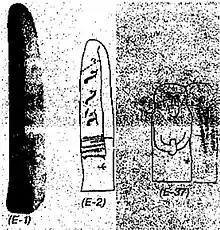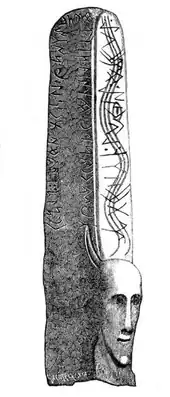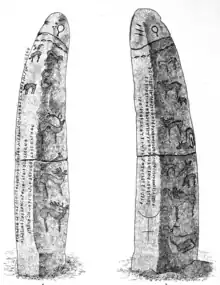The Yenisei Inscriptions are a series of Old Turkic inscriptions from the 8th-10th century CE, found near Yenisei Kyrgyz kurgans located in the Upper and Middle basins of the Yenisei River in modern-day Russia in Khakassia, Tuva and the Altai Republic.[1][2]

It is believed that Yenisei Inscriptions belong to different Turkic tribes living in Yenisei region. Some of these inscriptions, which are usually erected as tombstones, are a few words, most of them 5-10 lines. These inscriptions are written in a plain and no exaggeration language.[3] It is often seen that the author tells in a sincere language that they left this world without being satiated. Traces of Shamanism is also seen in the inscriptions.[4]
Period
Yenisei inscriptions used unique letters instead of some of the Orkhon letters that we see in Orkhon inscriptions. These are more primitive than the letters used in Orkhon inscriptions. The texts used in the inscriptions are also primitive compared to the Orkhon inscriptions and there are no long texts since all are tombstones. Therefore, it is thought to have been written before the Orkhon inscriptions.[3][5] However, dating studies point to the 8th-9th centuries.[6]



History of investigation
By 1983, 145 inscriptions were known, by 2006 - 184 inscriptions,[10] and as of 2013, 225 inscriptions have been found.[11]
Inscriptions of Yenisei tribes
The inscriptions were named with the name of the river, village or region where they were first found, and were indicated with numbers such as E-1, E-50, e-150 in academic type. For example: Uyuk-Tarlak (Е-1), Barık I (Е-5), Barık II (Е-6), Elegest (Е-10), Begre (Е-11), Uybat I (Е-30) etc.[12][13][14][15]
List of Inscriptions[16][17][18]
- E1 ( Uyuk-Tarlak )
- E2 ( Uyuk-Arjan )
- E3 ( Uyuk-Turan )
- E4 ( Ottuk-Daş I )
- E5 ( Barık I )
- E6 ( Barık II )
- E7 ( Barık III )
- E8 ( Barık IV )
- E9 ( Kara-sug )
- E10 ( Elegest Yazıtı I )
- E11 ( Begre )
- E12 ( Aldı-Bel I )
- E13 ( Çaa-höl I )
- E14 ( Çaa-höl II )
- E15 ( Çaa-höl III )
- E16 ( Çaa-höl IV )
- E17 ( Çaa-höl V )
- E18 ( Çaa-höl VI )
- E19 ( Çaa-höl VII )
- E20 ( Çaa-höl VIII )
- E21 ( Çaa-höl IX )
- E22 ( Çaa-höl X )
- E23 ( Çaa-höl XI )
- E24 ( Inscriptions on Khaya-Uju rocks )
- E25 ( Oznachennoe )
- E28 ( Oçurı Аçurı )
- E27 ( Oya )
- E28 ( Altın-köl )
- E29 ( Altın-Köl )
- E30 ( Uybat I )
- E31 ( Uybat II )
- E32 ( Uybat III )
- E33 ( Uybat-IV )
- E34 ( Uybat-V )
- E35 ( Tuba I )
- E36 ( Tuba II )
- E37 ( Tes )
- E38 ( Ak-Yus )
- E39 ( Kara-Yus )
- E40 ( Taşeba )
- E41 ( Kemçik-Çıgrak )
- E42 ( Bay-bulun I )
- E43 ( Kızıl-Çıraa I )
- E44 ( Kızıl-Çıraa II )
- E45 ( Kejeelig-Hovu )
- E46 ( Tele )
- E48 ( Abakan )
- E49 ( Bay-bulun II )
- E50 ( Tuva stele «B» inscriptions )
- E51 ( Tıva III )
- E52 ( Elegest II )
- E53 ( Elegest III )
- E54 ( Ottuk Daş III )
- E55 ( Tuvian stele "G" )
- E56 ( Malinovka )
- E57 ( Suygyn )
- E58 ( Kezek-Hure )
- E59 ( Kerbis-baarı )
- E60 ( Sargal Aqsy )
- E61 ( Sulug-adır-aksı )
- E62 ( Kanımıldık-kobı )
- E63 ( Ortaa-Hem )
- E64 ( Ottuk Daş II )
- E65 ( Kara-bulun I )
- E66 ( Kara-bulun II )
- E67 ( Kara-bulun III )
- E68 ( El-Bajı )
- E69 ( Çer-Çarık )
- E70 ( Elegest IV Eer Hol )
- E71 ( Podkuninskoe )
- E72 ( Aldı Bel II )
- E73 ( Yime )
- E74 ( Samagaltay )
- E75 ( Küten-Buluk )
- E76 ( Mirror I )
- E77 ( Mirror II )
- E78 ( Inscription on Chinese copper coin I )
- E79 ( Inscription on Chinese copper coin II )
- E80 ( Bronze Plaque )
- E81 ( Golden Vessel I )
- E82 ( Golden Vessel II )
- E83 ( Uybat VII )
- E84 ( Mirror III )
- E85 ( Mirror IV )
- E86 ( Amulet Signs )
- E87 ( Text on a Spindle )
- E88 ( Text on an Amulet )
- E89 ( Övür-I )
- E90 ( Övür-I )
- E91 ( Bedelig )
- E92 ( Demir-Sug )
- E93 ( Yur-Sayur I )
- E94 ( Yur-Sayur II )
- E95 ( Xemçik-Bom I )
- E96 ( Xemçik-Bom II )
- E97 ( Xemçik-Bom III )
- E98 ( Uybat VI )
- E99 ( Ortaa-Tey )
- E100 ( Bayan-Qol )
- E102 ( Arjan II inscriptions )
- E103 ( Arjan II inscriptions )
- E104 ( Oznachennoe II )
- E105 ( A Stele from Kyzyl Museum )
- E108 ( Uyuk Oorzak I )
- E109 ( Uyuk Oorzak II )
- E110 ( Uyuk Oorzak III )
- E111 ( Tepsey I )
- E112 ( Tepsey II )
- E113 ( Tepsey III )
- E114 ( Tepsey IV )
- E115 ( Tepsey V )
- E116 ( Tepsey VI )
- E117 ( Tepsey VII )
- E118 ( Turan I )
- E119 ( Saglı / Balbal Inscription in Saglı )
- E120 ( Tugutüp I )
- E121 ( Tugutüp II )
- E122 ( İyme II )
- E123 ( Tepsey VIII )
- E124 ( Tepsey IX )
- E125 ( Tepsey X )
- E126 ( Tepsey XI )
- E127 ( Mirror V / Zerkale iz Minusinska )
- E128 ( Mirror VI )
- E129 ( Mirror VII )
- E130 ( Mirror VIII )
- E131 ( Bronz Levha / Bronz Söve Pervazı )
- E132 ( Uybat VIII / Uybat ÇaaTas Stone )
- E133 ( Kopön Altın Küp III / Kopyon Çaa-Tas Stone )
- E134 ( Ust-Sos )
- E135 ( Ust-Kulog )
- E136 ( Mugur-Sargol I )
- E137 ( Kres-Haya )
- E138 ( Kara-Yüs II / Ozernaya )
- E139 ( Çaptıkov Taşı / Çaptık Taşı )
- E140 ( Mugur-Sargol II )
- E141 ( Bow sheath from Aymırlıg Kurgan I / the inscription on the horn bow I )
- E142 ( Bow sheath from Aymırlıg Kurgan II / the inscription on the horn bow II )
- E143 ( Mirror IX )
- E144 ( Novosyolovo )
- E145 ( Mugur-Sargol III )
- E146 ( - )
- E147 ( Yeerbek I )
- E148 ( Mugur-Sargol II )
- E149 ( Yeerbek II )
- E150 ( - )
- E151 ( - )
- E152 ( Şançı 3 )
- E153 ( Alash I )
- E154 ( Alash II )
- E155 ( Lisiç'ya I )
- E164 ( Adrianov )
References
- ↑ Kormushin, Igor (2019). "Yenisei runiform inscriptions and Turkic languages in the Yenisei Basin in the 8th - 10th centuries". Turkic Languages. 23 (2): 153–162.
- ↑ "Yenisey Yazıtları » Sümbül Sokak" (in Turkish). 2021-02-12. Retrieved 2022-04-01.
- 1 2 "Yenisey yazıtları ve özellikleri: Yenisey yazıtları nedir, kime aittir?". Sabah (in Turkish). Retrieved 2022-04-01.
- ↑ Davletov, Nükhet OKUTAN; Davletov, Timur (2022-01-01). "Eski Türklerden Günümüze Altay Şamanizminde Çök/Sök Ayini". Journal of Old Turkic Studies (in Turkish). 6 (1): 21–38. doi:10.35236/jots.987916. S2CID 245622796.
- ↑ Kılıç, Hüseyin (2002-03-01). "Yenisey Yazıtları". Çalakalem (in Turkish). Retrieved 2022-04-01.
- ↑ Aydin, Erhan (2012). "Yenisey Yazıtları nasıl tarihlendirilebilir?". Turkish Studies (Elektronik). 7 (2): 161–168. ISSN 1308-2140.
- ↑ Bazin, Louis (1990). "Les premières inscriptions turques (VIe-Xe siècles) en Mongolie et en Sibérie méridionale". Arts Asiatiques. 45 (1): 53, Fig.6. doi:10.3406/arasi.1990.1278.
- ↑ Rentzsch, Julian; Yıldız, Hülya (8 June 2020). "Uybat I". Uybat I. De Gruyter. p. 9. ISBN 978-3-11-067577-1.
The stele bears a carved-out human face at the bottom, of which Kormušin (1997: 91) states that archaeologists date it to no later than the 2nd millennium B.C.E. without specifying a concrete source. The stone was brought to the Mart'janov Museum of Local Lore in Minusinsk (Minusinskij regional'nyj kraevedčeskij muzej imeni N.M. Mart'janova) at the end of the 19th century, where it is kept under inventory no. 7 (Kormušin 1997: 91).
- ↑ Bazin, Louis (1990). "Les premières inscriptions turques (VIe-Xe siècles) en Mongolie et en Sibérie méridionale". Arts Asiatiques. 45 (1): 53, Fig.8. doi:10.3406/arasi.1990.1278.
- ↑ "Yenisey Bölgesi Yazıtları (184 yazıt)". UQUS TÜRK (in Turkish). 2012-02-12. Retrieved 2022-04-24.
- ↑ Şemen, Serkan (2017-07-24). "Some Explanations on Yenisey Inscriptions". Journal of Old Turkic Studies (in Turkish). 1 (2): 64–73.
- ↑ "Arşivlenmiş kopya". Archived from the original on 22 February 2016. Retrieved 1 August 2016.
- ↑ "Arşivlenmiş kopya". Archived from the original on 7 September 2016. Retrieved 1 August 2016.
- ↑ "Arşivlenmiş kopya". Archived from the original on 4 March 2016. Retrieved 1 August 2016.
- ↑ "Arşivlenmiş kopya". 12 February 2012. Archived from the original on 13 October 2016. Retrieved 1 August 2016.
- ↑ Aydin, Erhan (2011-10-01). "YENİSEY YAZITLARINDA GEÇEN UNVANLAR VE UNVAN NİTELEYİCİLERİ". Türk Dili Araştırmaları Yıllığı - Belleten. 59 (2): 5–26. ISSN 0564-5050.
- ↑ Aydın, Erhan. "Yenisey Yazıtları / Yenisei Inscriptions. Konya, 2015: Kömen Publ".
{{cite journal}}: Cite journal requires|journal=(help) - ↑ Yildiz, Aygün; Çolak, Kerem (2020-12-25). "Sosyal Bilgiler Dersi Öğretim Programı'nda Yer Alan Değerler Kapsamında Yenisey Yazıtlarının İncelenmesi". Değerler Eğitimi Dergisi (in Turkish). 18 (40): 77–113. doi:10.34234/ded.698299. ISSN 1303-880X. S2CID 229661058.
Further reading
- https://www.onturk.net/yenisey-yazitlari
- Yenisei inscriptions Archived 2013-01-28 at the Wayback Machine
- Yenisey Yazıtları toplu halde Archived 2016-10-13 at the Wayback Machine